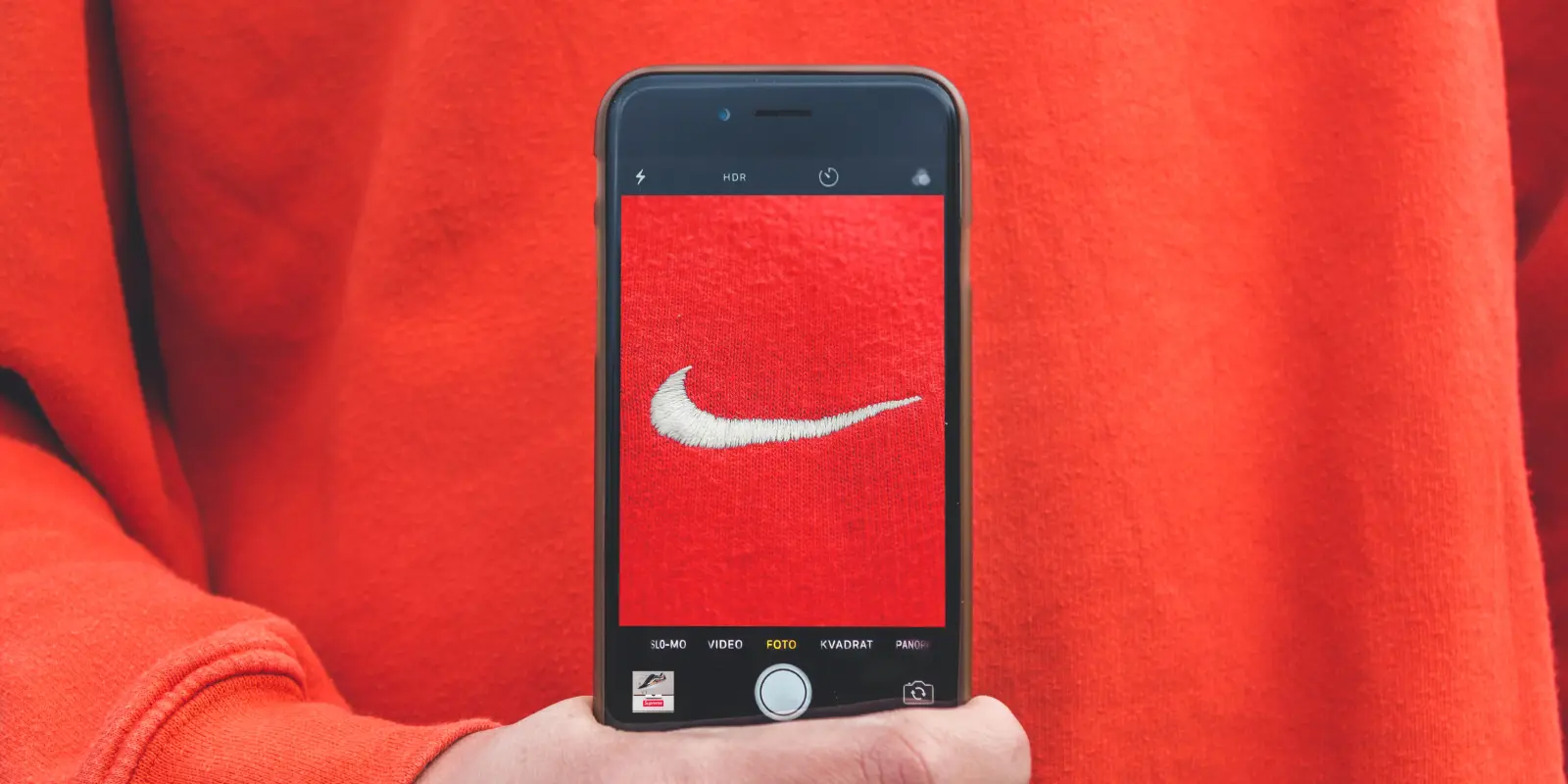Nowadays, it’s all about brand building. Whether you’re specialized in educating and consulting other businesses, or have a small business that’s trying to make it in the big world, you need a strong brand to push through the competition.
Luckily, you no longer have to be Coca-Cola or Nike to establish a brand. But you do need platforms to reach your target audience and a great brand building strategy in place.
By building a strong and recognizable brand you’ll be able to increase your revenue and diversify your offering under one umbrella.
And this is where a brand brief can help you out. A brand brief allows you to create a single document that outlines all the important aspects of your brand building and makes it transparent for everyone who needs to be involved in the process.
So if you’re looking to transform your business into a recognizable brand, keep reading to learn everything there is to know about the brand brief and start working on it ASAP.
Let’s dive in!
What is a brand brief?
A brand brief is a document that holds all important information about a brand which serves as a starting point for all your company’s strategic marketing efforts. In short, the brand brief is like a cheat sheet for your brand, containing all the stuff that makes it unique and memorable.
It’s a quick rundown of where your brand comes from, what it stands for, and where it’s headed. This document holds information on who your audience is and contains details about your logo, colors, and brand personality, along with a brand style guide.
It’s not just about looking good, though. The brand brief dives into how your brand talks, ensuring your voice stays true. Plus, it scopes out the competition, sets goals, and even draws a roadmap for your budget and timeline. In a nutshell, this is your brand’s backstage pass, making sure everyone in the company is maintaining a consistent narrative.
Supercharge your marketing reviews
Share, review, and approve all your content in one place with Filestage.
Five benefits of a concise brand brief
A concise brand brief, which effectively captures the key elements of a brand’s identity and strategy, offers several benefits for your business.
Here are the five most important advantages of having a concise brand brief:
- Consistency across communication channels
- Efficient decision-making
- Effective collaboration
- Enhanced brand recognition
- Improved customer understanding
1. Consistency across communication channels
A well-crafted brand brief ensures a uniform and consistent representation of the brand across various communication channels. From advertising materials to social media and beyond, a concise brand brief serves as a guide, preventing discrepancies and fostering a cohesive brand image.
2. Efficient decision-making
With a clear brand brief in hand, decision-makers can make informed and efficient choices. The documented guidelines and key elements streamline the decision-making process, whether it involves visual design choices, messaging strategies, or marketing initiatives.
3. Effective collaboration
A brand brief serves as a reference point for cross-functional teams and external partners. By clearly outlining the brand’s identity, values, and objectives, collaboration becomes more effective. Different teams can work in harmony, contributing to a unified brand representation.
4. Enhanced brand recognition
A concise and convincing brand brief helps in creating a distinctive and memorable brand identity. Consistent visual elements, messaging, and positioning contribute to enhanced brand recognition, making it easier for the target audience to identify and remember the brand.
5. Improved customer understanding
The process of creating a brand brief often involves a deep dive into understanding the target audience. This understanding, documented in the brand brief, helps in tailoring marketing strategies to resonate with customers. A well-crafted brand brief facilitates a stronger connection between the brand and its audience by addressing their needs and preferences.
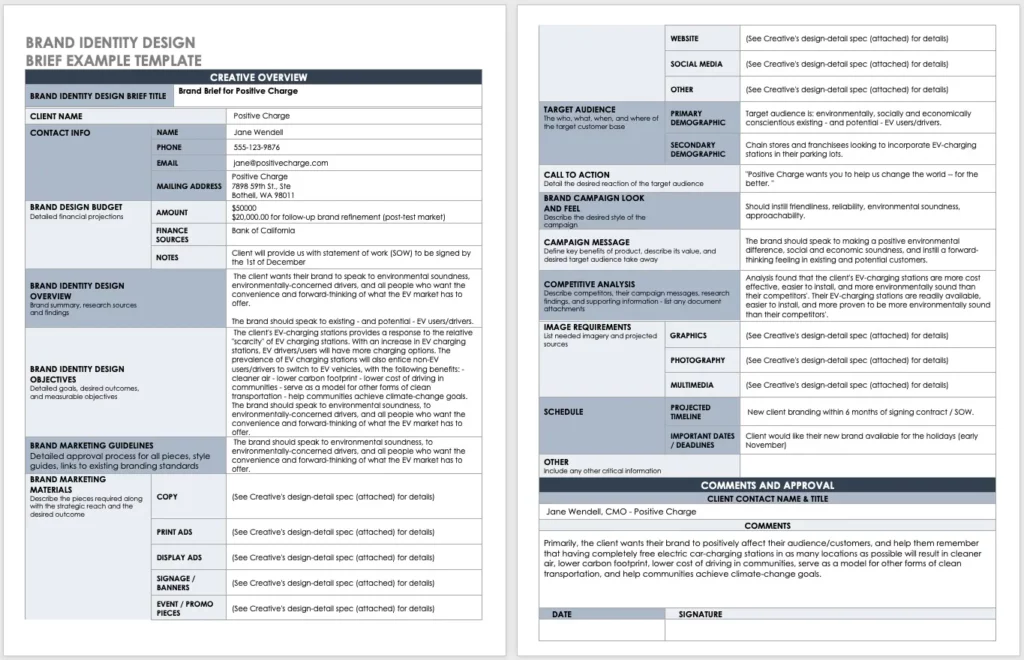
Source: smartsheet.com
Seven key components of a successful brand brief
A brand brief is a foundational document that provides essential information to guide the development of creative work, such as design, advertising, or marketing campaigns.
Here are the seven key components of a successful brand brief:
- Target audience – Clearly define the primary and secondary target audiences. Understanding the demographics, psychographics, and behaviors of the audience will be crucial for tailoring your brand messaging.
- Unique selling proposition (USP) – Identify and articulate the brand’s unique selling points that differentiate you from your competitors. You could include various product features, brand promise, brand values, and mission, or a particular market niche.
- Brand positioning – Define the brand’s position in the market and how it wants to be perceived by the target audience. This includes identifying competitors and outlining the brand’s competitive advantage.
- Brand personality and tone of voice – Describe the brand’s personality traits and establish guidelines for its tone of voice. Whether the brand is authoritative, friendly, or innovative, consistency in your brand voice is key.
- Visual identity – Outline the visual elements that make up the brand identity, such as logo, color palette, typography, and imagery. This is where your creative ideas can come into play. Afterwards, you can specify guidelines for their usage to maintain visual consistency.
- Brand touchpoints – Identify the various touchpoints where the brand interacts with the audience, including online and offline channels. This could encompass marketing materials, social media, packaging, and customer service.
- Brand guidelines and standards – Provide a set of guidelines and standards for maintaining consistency across all brand-related activities. This ensures that everyone involved, both internally and externally, adheres to the established brand identity.
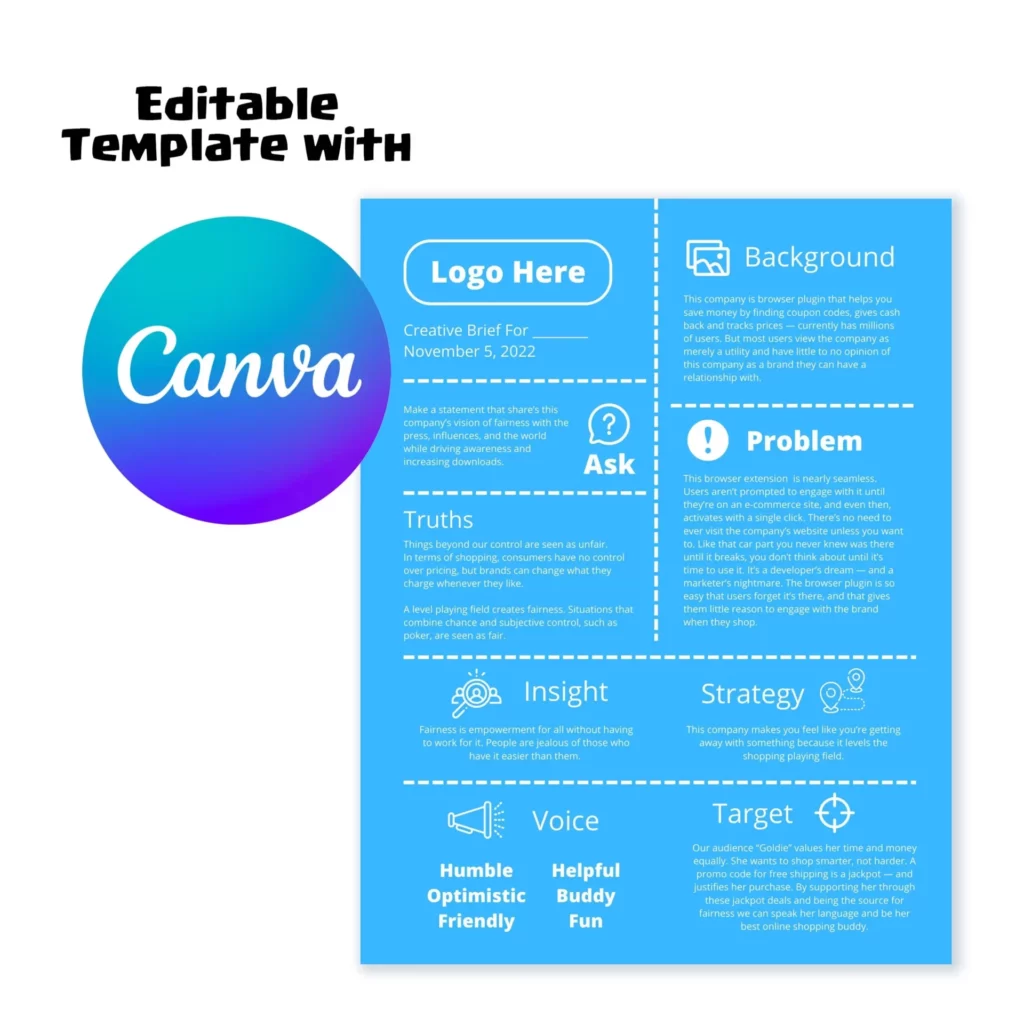
Source: etsy.com
Brand brief vs. creative brief – what’s the difference?
Brand brief and creative brief are similar terms that can seem quite confusing at first. But despite the fact that both briefs are essential tools in the world of marketing and branding, they have different purposes and focus on different aspects of the brand development process.
Here are the key differences between a brand brief and a creative brief:
- Different purpose
- Various scope
- Focus on different time horizon
- Diverse audiences
Let’s look at each of those in more detail
Purpose
Brand brief
A brand brief is a comprehensive document that outlines the core aspects of a brand. It typically covers the brand’s mission, values, target audience, unique selling propositions, brand positioning, and overall strategy.
The key purpose of this brief is to provide a strategic foundation for all brand-related activities, and make sure that everyone involved understands the brand’s essence and long-term goals.
Creative brief
A creative brief is more focused on a specific project or campaign within the broader context of the brand. It provides guidance to creative teams (designers, copywriters, etc.) by detailing the objectives, key messages, target audience, tone of voice, and other relevant information specific to the creative task you’re working on.
Scope
Brand brief
The scope of a brand brief is broad and encompasses the overarching brand strategy and identity. You can look at it as a reference point for various stakeholders involved in shaping and maintaining the long-term brand identity.
Creative brief
The scope of a creative brief is narrower and project-specific. It’s usually created for a particular marketing initiative, advertising campaign, or design project, providing detailed instructions for executing a specific piece of creative work.
Time horizon
Brand brief
A brand brief is often an underlying document with a more long-term focus. It sets the tone for the brand’s long-term development and may be revisited and refined periodically to reflect changes in the business environment or brand strategy.
Creative brief
A creative brief is more short-term and is closely tied to the timeline of a specific project or campaign. Once the project is complete, the creative brief may have less relevance, although lessons learned from it may get you more informed for the future.
Audience
Brand brief
The primary audience for a brand brief includes internal stakeholders, like the company leadership, employees, and other key decision-makers. It’s a strategic document that guides the overall direction of your brand.
Creative brief
The primary audience for a creative brief includes members of the creative team responsible for executing specific marketing or advertising materials. It provides the necessary information and context for specific team members to develop compelling and on-brand creative assets.
The importance of a well-crafted brand brief
A well-crafted brand brief is a crucial tool in the process of developing and managing a brand. It serves as a roadmap that guides the creation, communication, and maintenance of a brand identity.
Plus, it’s a foundational document that ensures a brand’s clarity, consistency, and effectiveness.
This brief serves as a valuable tool for both strategic planning and tactical execution in the dynamic and competitive landscape of branding. And watch out. You’ll also need to keep it updated with every brand refresh you do.
Here are several reasons why a well-crafted brand brief is important:
- Clarity and alignment – A brand brief provides you with a clear and concise overview of the brand’s purpose, values, and positioning. It makes sure that everyone involved in brand development and communication, both internally and externally, is on the same page. This alignment is essential for maintaining a consistent brand image.
- Guidance for creativity – Creative teams, including designers, copywriters, and marketing professionals, rely on a brand brief to understand the brand’s personality, target audience, and unique selling propositions. This information is crucial for creating compelling and consistent brand assets and messaging. And it helps to simplify the creative review and approval process.
- Consistency – Consistency is key in building brand recognition and trust. A well-crafted brand brief outlines the specific elements of the brand, such as logo usage, color palette, typography, and tone of voice. This consistency helps you create a cohesive and recognizable brand identity across different channels and touchpoints.
- Efficient decision-making – The brand brief acts as a reference point for decision-making related to your brand. When faced with choices about messaging, design, or marketing strategies, referring back to the brand brief helps you make sure that decisions align with the overall brand strategy.
- Effective communication – Internally, a brand brief helps you communicate the essence of the brand to employees and make sure that everyone understands and embodies the brand values. Externally, it serves as a tool for communicating the brand’s story and value proposition to customers, partners, and the wider audience.
- Facilitates collaboration – In a collaborative work environment, different teams and individuals contribute to various aspects of the brand. A brand brief provides a common foundation for collaboration and helps you make sure that diverse contributions align with the overarching brand strategy.
- Facilitates brand evolution – As brands evolve over time, the brand brief serves as a living document that can be updated to reflect changes in the market, business goals, or customer preferences. It helps you guide the evolution of the brand in a purposeful and strategic way.
- Measuring success – A brand brief often includes key performance indicators (KPIs) and goals. This allows for the measurement of the success of branding efforts over time, helping organizations understand what is working and what might need adjustment.
11 steps to create a brand brief template
Creating a brand brief template involves collaboration and feedback from various stakeholders to make sure you end up with a comprehensive brand in the end.
With this brand brief example template you’ll create a dynamic document that can be used for each specific project or campaign. This will make sure you have a consistent and effective representation of the brand across different initiatives.
Here’s a step-by-step guide to creating a brand creative brief template.
Step 1: Document information about the brand
Create a detailed brand overview. This includes:
- Brief history and background of the brand
- Mission and vision statements
Step 2: Define the target audience
There are two important elements to defining your target audience:
- Demographics – Age, gender, location, income level, etc.
- Psychographics – Interests, values, and lifestyle choices
Step 3: Outline brand positioning
Brand positioning is all about finding your brand’s unique selling propositions (USPs) and the desired perception of your brand. This is an important part of the branding process as it allows you to highlight your specialty while diversifying your brand’s style, brand tone, and brand design from everyone else on the market.
Here’s what to ask yourself when defining both:
- UPS – What sets our brand apart from competitors?
- Desired perception – How do we want our brand to be perceived in the market?
Step 4: Detail brand personality
Every brand should have a personality. It can be friendly, playful, and relatable, or serious and knowledgeable. Whatever is the case for your business, make sure to choose the right set of adjectives that will portray your brand’s personality in the most accurate way possible.
Based on the personality of your brand, you’ll then have to develop tone of voice guidelines so that everyone at your company has a clear understanding of how the brand should communicate with its audience.
Here are a few things you should include in the tone of voice guidelines:
- Whether to communicate more formally or informally
- The use of conversational or more technical language
- The use of abbreviations
- How to spell out numbers (in icons or letters)
- Whether to use sentecase or title case in the headings
Step 5: Craft visual identity guidelines
When crafting your visual identity guidelines, make sure to give clear instructions on:
- Logo specifications – Create different versions, sizes, and define clear space
- Color palette – Define primary and secondary colors
- Typography – Which fonts should be used in various contexts
Step 6: Develop key messages
In an attempt to build a strong branding project, you’ll need to develop key messages that will become recognizable for the brand. These messages should communicate the brand’s personality while pointing out its mission.
Out of the key points that you decide to convey with your brand, you’ll then formulate short, memorable phrases associated with the brand. Or, in other words – taglines and slogans.
Step 7: Analyze the competitive landscape
A big part of building brand briefs is conducting a thorough analysis of your competitors. Only when you know who your competitors are can you start to diversify your brand and build something unique.
Here’s what to look into as a part of your competitor analysis:
- Strengths, weaknesses, opportunities, threats (SWOT analysis)
- How the brand positions itself relative to competitors
Step 8: Set marketing objectives
A small startup will always have completely different objectives from an international corporation, regardless of the industry. And this set of marketing objectives will directly reflect on your brand brief. It will set a direction for the company and consequently your marketing strategy.
That’s why it’s important to set short-term and long-term goals and define clear and measurable objectives aligned with the brand’s vision.
Step 9: Establish budget and timeline parameters
Once you have clear objectives in place, it’s time to work on the least fun part of your brand brief – the budget and timelines.
When it comes to the budget, you should define what resources you can allocate for brand-related activities. And for the timeline, it’s important to establish deadlines for specific brand initiatives and track their progress.
Step 10: Finalize and review
One of the final steps of your brand brief is the internal review. Brand brief is a big company project and requires multiple stakeholders’ involvement for the best possible outcome. Therefore, try to gather input from cross-functional teams and make sure all components align with the brand’s strategy.
With Filestage’s document approval software, you can set up a clear and efficient process for sharing and reviewing your brand brief with stakeholders.
Step 11: Document revisions and updates
No brand brief is a final document. And every major change in the company’s strategy can drastically affect your brand brief. That’s why you should establish version control to maintain a system for tracking revisions. Plus, version control will allow you to update the template as needed based on brand evolution.
Six examples of great brand culture
Once you create a strong brand brief, you’ll be able to develop a great brand culture and transform your business into a recognizable brand force. A great brand culture is characterized by a set of values, beliefs, and behaviors that your organization and your employees consistently live by.
Here are six examples of companies with notable brand cultures:
1. Coca-Cola: Positive and inclusive culture
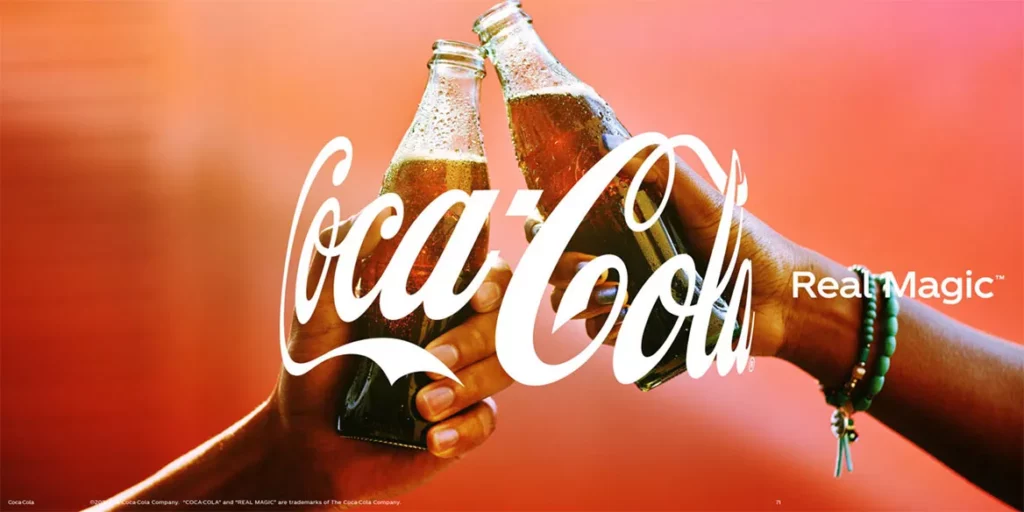
Source: cocacola.com
Coca-Cola nourishes a great brand culture through timeless values, global unity, and innovation. Consistent branding, emotional storytelling, and community engagement contribute to a positive and inclusive culture.
Iconic traditions and employee engagement further reinforce the brand’s impact, making Coca-Cola more than a product – it’s a symbol of shared joy and connections.
2. Google: Innovation and collaboration

Source: google.com
Google is renowned for its innovative and collaborative culture. The company encourages employees to explore new ideas, take risks, and allocate time for personal projects.
The open and collaborative work environment at Google fosters creativity and has contributed to the development of groundbreaking products and services.
3. Patagonia: Environmental and social responsibility

Source: theeverydayagency.com
Outdoor clothing company Patagonia has a strong brand culture centered around environmental and social responsibility.
The company is committed to sustainable business practices, ethical sourcing, and environmental activism. Patagonia encourages its employees to live the brand’s values and supports various environmental initiatives.
4. Nike: A force of empowerment
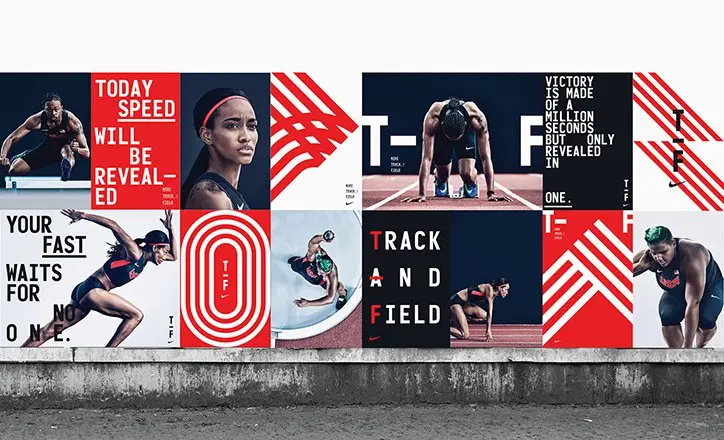
Source: itsnicethat.com
Nike embodies a notable brand culture by consistently emphasizing innovation, empowerment, and athletic excellence. The “Just Do It” slogan encapsulates its ethos of determination and personal achievement.
Through high-profile endorsements, cutting-edge product design, and social impact initiatives, Nike fosters a global community that celebrates athleticism and self-expression. This commitment to a dynamic and inclusive culture not only distinguishes Nike in the sportswear market but also resonates deeply with consumers worldwide.
5. Southwest Airlines: Employee empowerment
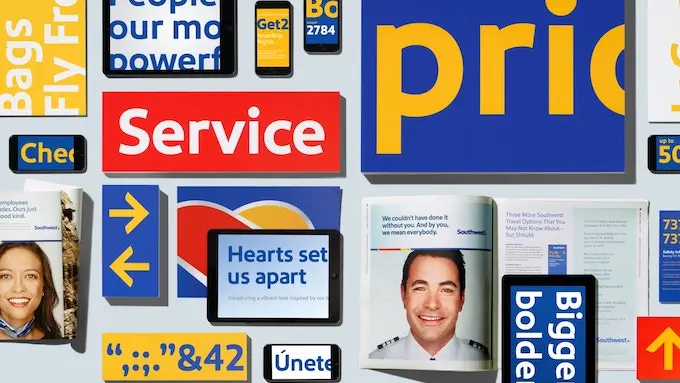
Source: lippincott.com
Southwest Airlines is known for its unique and employee-friendly culture. The airline emphasizes the importance of employees as a crucial part of the company’s success.
Southwest empowers its employees to make decisions that benefit both the company and its customers, fostering a sense of ownership and accountability.
6. Salesforce: Ohana culture

Source: salesforce.com
Salesforce, a cloud-based software company, promotes an “Ohana” culture, a Hawaiian term for family. The company emphasizes inclusivity, support, and a sense of belonging among its employees.
Salesforce is committed to giving back to the community, and employees are encouraged to participate in volunteer activities, further reinforcing the Ohana culture.
Final thoughts
Once you develop a brand brief, everyone at your organization will have a clear understanding of what your brand is, what it stands for, and in which direction it’s going. And at the end of the day, your business will experience numerous benefits from building a strong brand.
So now that you’re equipped with all the knowledge you need to build a solid brand brief, it’s time to roll up your sleeves and get to work! No brand will build itself.
And if you need help getting feedback and approval from your team, Filestage is here to help. Get started today with a free trial →

